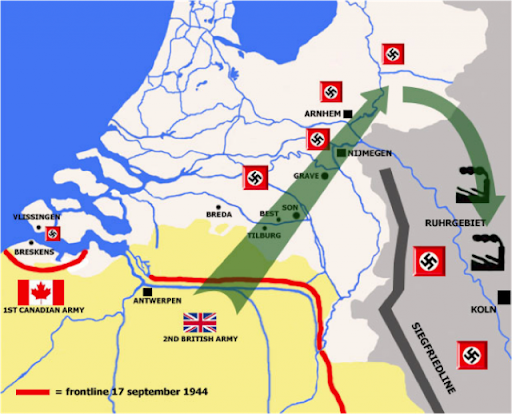In the middle of September 1944, the Allies planned and executed the largest aerial invasion in history to capture a series of bridges in Nazi-occupied Holland, hoping to end the war by Christmas.
If you know your WW2 history, "Operation Market Garden" was generally considered a failure, as the Allies suffered HEAVY losses and could not capture and hold their final and most important objective, the bridge over the Rhine in Arnhem.

The main reason for the failure was that the Allies ignored critical intelligence collected from aerial reconnaissance, Ultra intercepts, and the Dutch resistance indicating the presence of multiple armored Panzer divisions in the region. While valiant, the lightly armed and ill-supplied paratroopers that landed in Arnhem were no match for tanks!
With more and more organizations investing heavily in competitive intelligence teams and analysis, you'd think they would be eager to act on the analysis those teams provide. But like the Allies during Operation Market Garden, this intelligence is often collected, assessed at great expense, and then ultimately ignored.
Operation Market Garden serves as a case study for organizations about the importance of not just gathering accurate intelligence, but actually using it to enable your customer facing teams, and to inform strategic decision making.
Let's explore some of the reasons why intelligence is often ignored and what we can do to change it.
Lack of trust
Decision-makers within organizations may lack trust in the accuracy or relevance of the intelligence gathered or even in the people creating and delivering it. They may have received misleading or unreliable information in the past, leading to skepticism and hesitation to act based on intelligence.
Also, even though they invest heavily in competitive intelligence, business leaders may only want information that confirms pre-existing beliefs and strategies.
Solution
- Establish a track record of delivering accurate and actionable intelligence by ensuring rigorous data collection and analysis processes.
- Foster open and transparent communication between the intelligence team and decision-makers to build trust and credibility.
- Provide concrete examples of how intelligence has positively influenced strategic decisions and outcomes in the past, even when it challenged accepted thinking.
Overconfidence
Overconfidence is like a blindfold that keeps you from seeing the next disruptor of your business. Remember Blockbuster? While they were focused on Hollywood video eating away at their market share, Netflix and other streaming platforms came along and totally disrupted their business model.

Solution
- Humble thyself! Previous success does not guarantee future success.
- Run through a Porter's 5 Forces analysis of your respective market at least once a year. This will force you to consider the strength of threats like new entrants and replacements.
- Gain a new competitive perspective by asking, "What is your competition most afraid of you doing?"
Organizational culture
Certain organizational cultures may discourage proactive decision-making or discourage challenging the status quo. This can create a reluctance to act on intelligence that may contradict established beliefs or disrupt existing processes.
Solution
- Foster a culture of curiosity, adaptability, and openness to new ideas and insights.
- Encourage cross-functional collaboration and interdisciplinary discussions to challenge existing assumptions and promote a culture of informed decision-making.
- Recognize and reward individuals and teams that demonstrate the value of acting on intelligence.
Inadequate communication
Effective communication channels and processes are essential for disseminating intelligence throughout an organization. But like the telephone game, if the intelligence is not effectively communicated to the relevant decision-makers or if the value and implications of the intelligence are not effectively conveyed, it can lead to inaction.
Solution
- Competitive intelligence should ALWAYS be interactive! Set up channels for sharing intelligence updates and encourage feedback and discussion.
- Develop clear and concise intelligence reports that highlight key findings, implications, and recommendations.
- Tailor communication to the specific needs and preferences of decision-makers, using visualizations and storytelling techniques to convey insights effectively.
Inertia and risk aversion

Just like people, organizations and businesses may be resistant to change and reluctant to take risks. Acting on intelligence often involves making strategic decisions that have potential risks and uncertainties. Fear of failure or negative consequences can lead to a preference for maintaining the status quo rather than acting on intelligence-driven insights.
Solution
- Invoke the "fear" motivator by educating decision-makers about the potential risks of inaction and the missed opportunities associated with not acting on intelligence.
- Promote wisdom and pragmatism by adopting a mindset that embraces calculated risks and experimentation, emphasizing the potential rewards of seizing strategic opportunities.
- Provide decision-making frameworks and tools that help evaluate and mitigate risks associated with intelligence-driven decisions. Some examples are scenario analysis, SWOT analysis, risk heat maps, competitor profiling, and war gaming.
Resource constraints
Acting on intelligence may require additional resources, whether financial, human, or technological. Organizations with limited resources may struggle to allocate the necessary resources to act on intelligence, especially if the perceived benefits or urgency of the intelligence is not fully understood or compelling enough.
Solution
- Prioritize and allocate resources based on the strategic importance and potential impact of intelligence.
- You can explore partnerships or collaborations with external intelligence providers to add more internal capabilities.
- Invest in technology solutions that automate data collection and analysis processes, freeing up resources for decision-making and action.
To close, I can't stress enough how important it is to remember that competitive intelligence is only as valuable as the actions it inspires. Businesses must not only invest in gathering and analyzing intelligence but also in creating an environment where it can be effectively used to inform strategic decisions.
Put yourself in first place 🥇
Differentiation is critical. In today's job market, interview processes have four, five or even more stages. Competition is fierce, and proving your worth is getting harder.
How valuable would it be to you to be able to bypass all that in the eyes of the recruiter, because they’re already familiar with your work?
We're offering you the means to do just that.
We’ll work with you to quickly adapt your work into SEO-optimized articles, ghostwritten guides, and podcast episodes.
It’s never been easier to differentiate yourself, so why not start today?
Sound interesting? Send us a message at contribute@competitiveintelligencealliance.io to discuss next steps. 🤝




.png?v=a38c2de9f4)